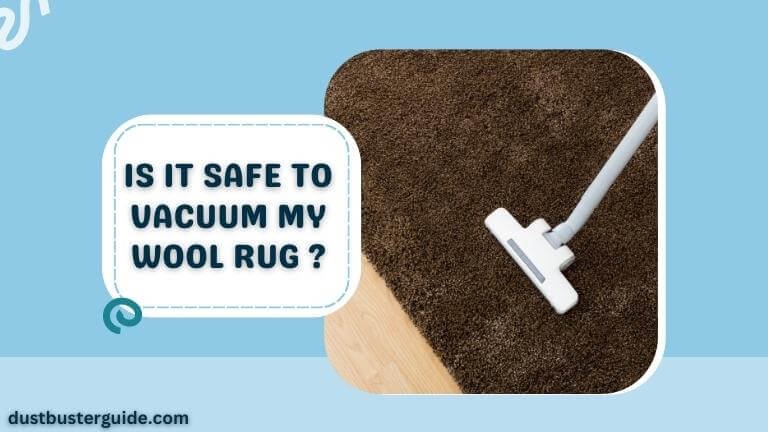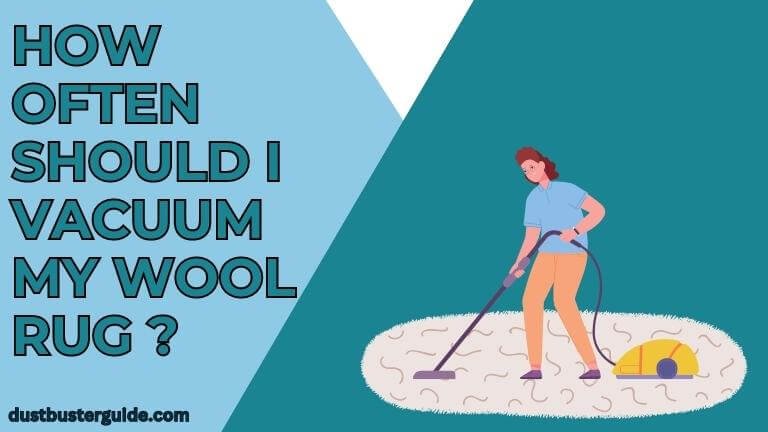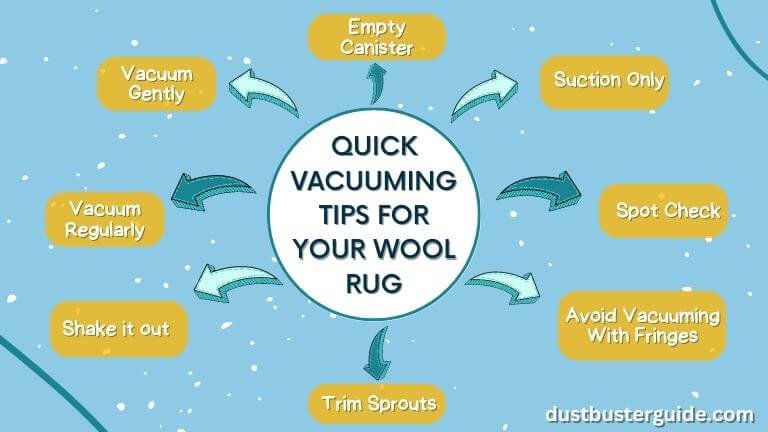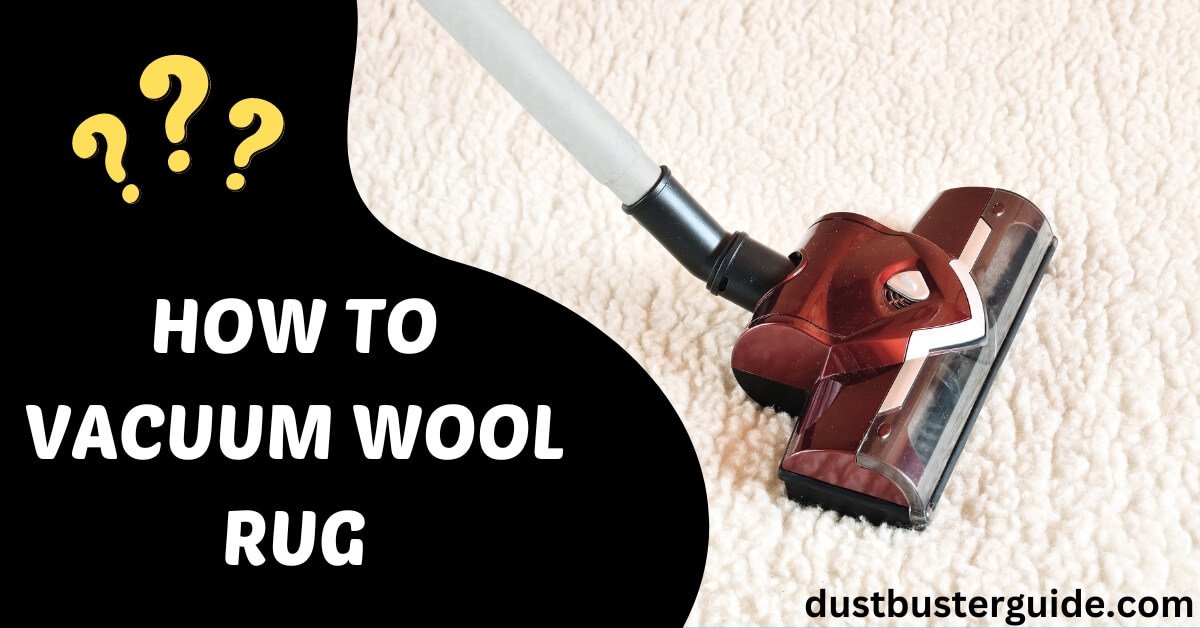Embarking on a wool rug cleaning mission and wondering, how to vacuum wool rug? Today, we’re delving into the delicate art of maintaining your cozy floor covering. Picture this: your wool rug as a luxurious treasure, deserving of a careful cleaning approach.
Here’s the scoop – when vacuuming a wool rug, use a vacuum cleaner with an adjustable beater bar or set the height adjustment to its highest setting to avoid excessive friction.
Additionally, make sure to vacuum in the direction of the rug’s nap. Join us on this cleaning expedition as we unveil the tips and tricks to keep your wool rug looking pristine.
Why Is It Important To Vacuum Wool Rugs
We believe that you should know the advantages of vacuuming them before learning how to vacuum wool rug. So let’s first determine that.
One of the best things you can do to extend the life of your rug and the interval between professional cleanings is to vacuum it properly. Having less dirt and soil in your carpeting also contributes to keeping your home clean. Routine vacuuming is essential since the typical rug may hold kilos of dirt before it even begins to look unclean.
If you don’t routinely vacuum your rug and it has been more than a year since a professional cleaner cleaned your wool rug, there will already be a significant amount of dirt buildup. Consequently, you’ll need expert cleaning because you cannot remove this debris alone. Regularly vacuuming your rug, even if it has just been professionally cleaned, will help you go longer between cleanings.
Is It Safe To Vacuum My Wool Rug

We can tell that you are inspired to vacuum your rug after reading about its advantages, but there is a question on your face, Are you unsure whether it is safe to vacuum your wool rug? You are not alone in your perplexity; we frequently receive inquiries about the safety of vacuuming wool rugs and why household vacuums might harm them. It depends on the quality of your vacuum and the type of wool rug. Woven, Tufted, and Shag are the three basic types of wool rugs.
Woven Rugs have patterns or knots that mirror images of the designs on the front. Tufted Rugs have latex holding them together, and the back is covered in material. The common long pile carpets we see everywhere these days are Shags Rugs.

No single vacuum cleaner is ideal for all three types of rugs. However, better vacuums give you more alternatives for utilizing suction or brushing capabilities. Power brushing is not as crucial as the vacuum’s suction. Since most vacuum brushes are designed for more durable carpets, they will be too harsh for your rug.
How To Vacuum Wool Rug
Now that you’re very much aware of the benefits of vacuuming your wool rug, are you not excited to know how to vacuum wool rug.
Different vacuuming strategies are needed depending on whether your wool rug is woven, tufted, or has a shag pile. One of the most effective ways to clean wool rugs at home is to think of it as dusting. And your rugs require frequent dusting for that.
You won’t be able to get ahead of the game when protecting your rug if you don’t regularly vacuum your carpets, and it has been at least two years since you washed your previous rug. Wash it, then start the customary dusting procedure. The idea is to prevent a buildup of dust or grit until the next cleaning because there shouldn’t be any (or very little) embedded soil in the foundation if you have just washed your rug.
Whatever vacuum you use, the suction rather than the power brushing is crucial for dusting. In actuality, the majority of brushes will be too rough for wool. Therefore, if you notice brush strokes on your rug, be aware that it is not a symptom of a good cleaning. It indicates that the rug is aging and that the pile is distorting.
It will be fantastic if we teach you the vacuuming techniques for each of the three main types of wool rugs separately because different types demand varying levels of care. So let’s look at them one at a time:
Vacuuming A Woven Wool Rug
Using an upholstery tool on your vacuum is preferable for cleaning thinner or low-pile woven carpets. Check the pile position by patting the rug. It’s crucial to vacuum alongside the pile rather than against it. In case you vacuum up against the pile, softer wool may break. When possible, vacuum the rug’s back to keep pests from making a home in the rug’s foundation.
Strong vacuuming is still not as effective on woven rugs with a thicker, longer, or more durable pile than conventional carpets. Your vacuum’s brush should now be off, and once more, vacuum with the pile rather than against it.
Vacuuming A Tufted Wool Rug
Tufted wool rugs are frequently of lower quality, so they collect and hold more dirt than woven rugs.
It indicates that the wool is frequently of inferior grade and is readily damaged. They also shed, making owners vacuum their rugs more frequently and vigorously than they would with woven rugs. This shedding may be the result of forceful vacuuming and tearing off tufts. To avoid separating the fibers from the glue, it is best to gently vacuum a tufted rug while moving with the pile. You should routinely take the tufted carpets to a professional rug wash to avoid costly repairs.
Vacuuming A Shag Pile Wool Rug
Cleaning Shag wool rugs is difficult. If you have ever looked at your rug and questioned how to clean it at home, you are not alone. Shag pile rugs have long fibers that may hold anything, including dead insects. You will need assistance to raise the rug and shake it out with the pile facing down. After that, place the rug back down and carefully vacuum each row of fibers by moving with the pile.
Avoid vacuuming the rug’s back since you might remove the pile. Like tufted carpets, having your wool rug washed by rug cleaning experts is preferable and safer. It can save you from spending money on costly rug repairs.
How Often Should I Vacuum My Wool Rug

Yes, we know that you have learned the procedure of how to vacuum wool rug, but one more important detail you should be aware of before you take out your vacuum: how frequently you should vacuum your wool rug. Your woolen carpet’s vacuuming and cleaning frequency rely on several factors; here are some of them:
Traffic
If many people walk over your woolen rug regularly, you should vacuum it twice or thrice weekly. If fewer people walk over the rug, you can vacuum it once weekly. It typically also depends on the location of the carpet: If it is kept in the living room, there will likely be a lot of foot traffic. The bedroom often has less activity.
Pets
Having pets is a significant element influencing how often you vacuum. Animals naturally lose hair and have dirt and grit on their paws, so pet-owning households need to clean their homes more frequently.
On the other hand, if you don’t have any pets at home, you can get away with one or two monthly vacuuming sessions for your wool rug.
Location
The place where your wool rug is located is also crucial. You should vacuum and clean this rug every two to three days if you keep it outside your home or in an area with higher dust. You can do it once a week or even once every two weeks if it is kept in a remote place with little human traffic.
Allergies and Asthma
It is a great idea to frequently clean or vacuum your carpets if any of your family members suffer from allergies or asthma. You also need to choose the best vacuum cleaner for asthma and allergies. It is because they are built with the greatest filtration and are sealed to guarantee that all the dust mites are contained and not released back into the house.
Things To Consider When Picking Your Wool Rug Vacuum

As we discussed earlier, the type and quality of your rug and the vacuum directly impact how well your wool rug cleans up after vacuuming. We have already discussed the former part (rug type); now is the time for the later part (vacuum type). We’re going to outline the key features you need to check in a vacuum before you buy one for your wool rug in this section:
Suction
As we already discussed, suction is crucial to take into account when choosing a vacuum for wool carpets. The trick is to strike a balance between wanting something that can soak up dirt and grime and not wanting anything that is too potent and harms the fibers of the wool. A vacuum with many suction settings is ideal so that you may use a stronger suction on different carpets and other surfaces.
Vibration Technology
Without being harsh on the rug’s fabric, vibration can assist in the release of dirt and other particles. It is a perfect substitute for a vacuum with more suction or a harsh beater brush. Even though this feature isn’t common, certain models do include it.
Size
It largely depends on individual taste. Before selecting a big vacuum, think about the size of your house and the number of steps/stairs.
Brush Type
Soft brushes are always preferred over rough brushes for wool rugs. By doing this, you may still clean the fibers while preserving their quality.
Type of Vacuum
All of the common vacuum types, including upright, cordless, and canister, have suitable models for wool carpets.
The most prevalent and generally preferred type is upright. These vacuums’ biggest drawback is cleaning beneath furniture, but you can fix this with accessories.
Using a cordless vacuum is convenient, but you should be aware that your options are now limited by the battery’s lifespan, which can be a problem.
Canister vacuums can be highly effective on many different surfaces, but they can be tricky to control on stairs.
Filter System
Make sure the vacuum you purchase has a top-notch filter system. It will safeguard the vacuum’s motor and keep your carpet cleaner. HEPA filters are strongly advised for families with allergy sufferers.
Versatility
Consider the variety of floors in your home when deciding if you would benefit from a vacuum with adjustable suction or a wide range of accessories. Doing this ensures that your home’s demands can be met by just one appliance.
Budget
Just like any other household appliance, there are different prices and levels of quality for vacuums for a wool rug. Think about your financial limitations as well as your level of need. Although the best vacuums for wool rugs are frequently on the more expensive side, there are certainly cheaper options.
Quick Vacuuming Tips For Your Wool Rug

So we have learned almost everything about how to vacuum wool rug, but below, we have added some quick vacuuming tips that will help you have an easy job vacuuming your wool rug:
- Vacuum gently: Beater bars are too rough and can hasten the degradation of wool rugs, so try to gently vacuum your rug. Additionally, slowly vacuum in both directions. By doing this, you can be sure that every bit of dirt is collected, and moving in both ways will fluff up the carpet.
- Vacuum regularly: Depending on how frequently the space is used and how much traffic it receives, including vacuuming your wool rug in your weekly or biweekly cleaning tasks to prevent excessive dirt buildup. Vacating the rug’s underside is also a good idea every few months. As they won’t wear as quickly, you can sweep newer rugs more regularly than older ones.
- Shake it out: To eliminate loose debris that would otherwise clog your vacuum, shake or lightly beat smaller rugs outside. Before moving on, flatten it out once more.
- Suction only: When vacuuming wool area rugs, suction is ideal. You should avoid the rough or heavy-duty bristles of a spinning brush or beater bars since they might suck up the rug’s finer fibers and cause premature and unneeded wear and tear.
- Spot check: After vacuuming, remove stains by spraying the rug with water. To protect the fibers, avoid rubbing and instead blot the stain. Avoid ammonia-containing cleaning products and highly alkaline cleaners because they will harm wool. Because wool can take a while to dry, blot it completely.
- Avoid vacuuming with fringes or tassels: Avoid vacuuming with fringes or tassels because they could unravel, get stuck, or come off the rug when exposed to suction. Cleaning them individually is preferable. To straighten and clean them, think about getting a wide-toothed comb.
- Empty Canister: Regularly clean out your vacuum. For the best wool carpet care, empty the vacuum bag or canister frequently and clean the beater bar.
- Trim Sprouts: If your wool rug begins to sprout, trim it rather than pull at it. Although sprouting is normal, pulling it will harm the remaining carpet.
What Is The Ideal Way To Remove Pet Vomit Out Of Wool Rug?
When dealing with pet vomit on a wool rug, prompt action is key. Begin by blotting the vomit with paper towels or a clean, white cloth to absorb as much liquid as possible. Carefully remove any solid components with a spoon or blunt knife.
Create a solution of mild dish soap and warm water, testing it in an inconspicuous area before applying it to the stain. Blot the affected area with the cleaning solution, working from the edges toward the center to prevent spreading. Rinse with clean water and blot to remove soap residue.
Absorb excess moisture with dry towels and allow the rug to air dry completely. Avoid heat sources during the drying process. Once dry, gently brush the wool fibers to restore the rug’s texture.
If the stain persists, or if you have concerns about cleaning a wool rug, consider consulting a professional carpet cleaner for expert assistance, and always adhere to the manufacturer’s care instructions.
Conclusion
We hope that by this point, you are thoroughly aware of how to vacuum wool rug and are prepared to pull out your vacuum and start the task. However, before you begin, be certain of the type of wool rug you wish to clean (woven, tufted, shag). When vacuuming wool rugs, use only suction. Do not use the hard bristles brush since they might suck up the rug’s finer fibers and cause early wear and tear. When vacuuming a wool rug, be careful to follow the pile direction by beginning on one side and moving to the other.
FAQs
Can you use a vacuum on a wool carpet?
Vacuuming is an essential part of care for your wool carpet. Given that a buildup of soil and dirt particles has the potential to harm carpet fiber, regular and thorough vacuuming can extend the life of the carpet. Regular vacuuming also aids in realigning a pile that has been disoriented due to wear.
How often do you vacuum a wool rug?
Regardless of how often they are regularly vacuumed, your wool rugs must be cleaned by professionals every one to three years. The amount of activity on the rug (how much traffic is in the area where the rug is located) and the rug’s quality influence how frequently it needs to be cleaned.
How do you vacuum a rug without ruining it?
Use the attachment to vacuum strips from top to bottom. Flip the rug over and begin cleaning from the bottom up. Do not vacuum the fringes on the sides of the rug if they are likely to be fragile. When vacuuming an ancient rug, carefully collect all the dirt without damaging any fibers.
Why is my carpet crunchy after I vacuum it?
If your carpet feels crunchy after you clean it, shampoo, detergent, or any other chemical may have been left in the fibers.
Is it okay to vacuum the carpet every day?
Regular vacuuming causes significantly less damage to carpets than dirt that is left behind. Although daily vacuuming may not be desired or required, it is still the best approach to maintaining a clean home.
How do you clean a wool rug at home?
Clean a wool rug at home by vacuuming regularly, using a mild detergent or wool-safe cleaner for spot cleaning, and blotting spills with a clean, damp cloth. Avoid excessive water and ensure proper drying.
What are the benefits of wool rugs besides being beautiful?
Besides their aesthetic appeal, wool rugs offer benefits such as natural stain resistance, durability, flame resistance, and the ability to regulate humidity in a room, making them a practical and cozy addition to home decor.
External Resources
- Modifications Of A Handheld Vacuum Cleaner For Noise Control – ResearchGate
- Psychoacoustic Analysis Of Vacuum Cleaner Noise – MDPI
- Design, Dirt And Disposal: Influences On The Maintenance Of Vacuum Cleaners – ScienceDirect
- Typical Household Vacuum Cleaners: The Collection Efficiency And Emissions Characteristics For Fine Particles – Taylor & Francis Online

